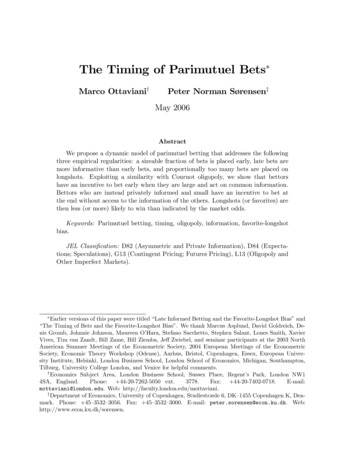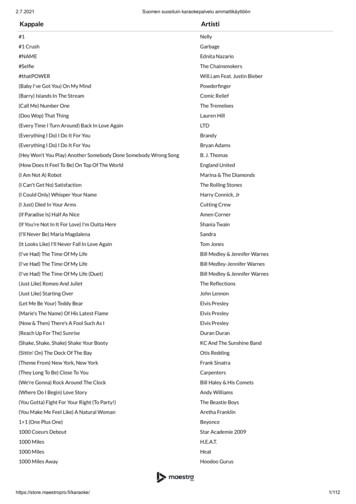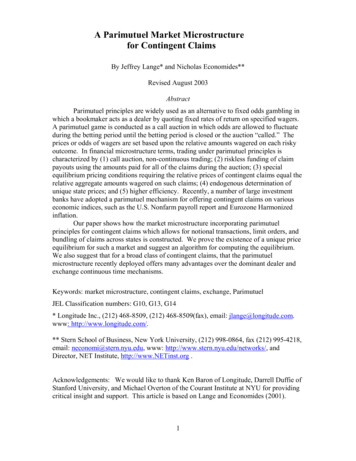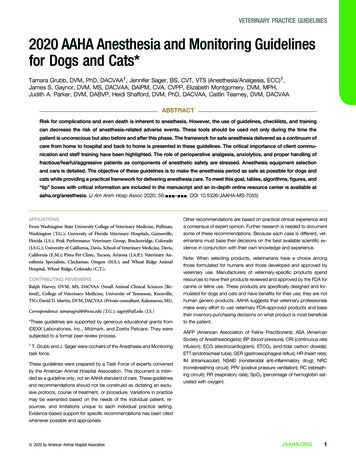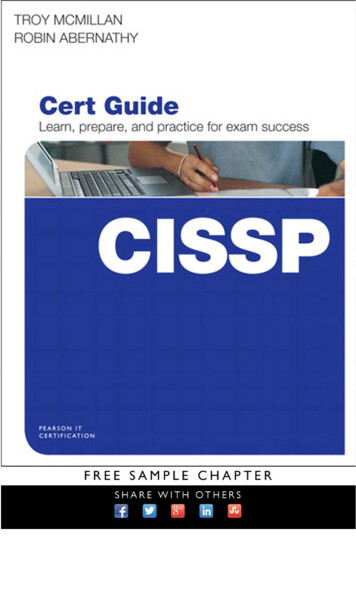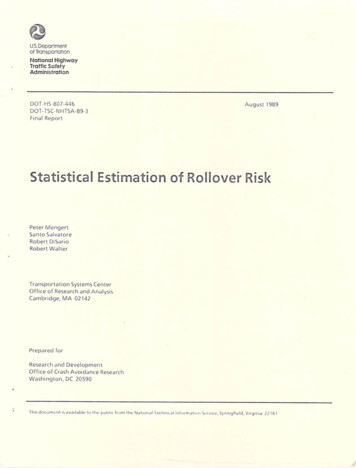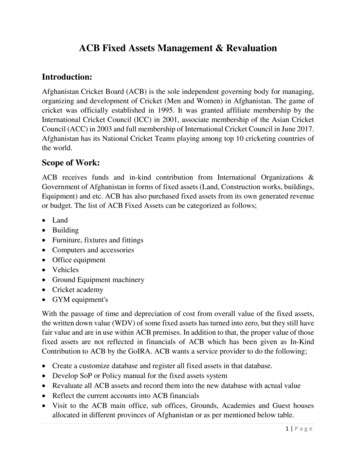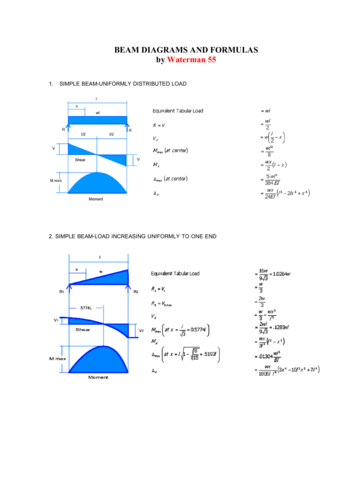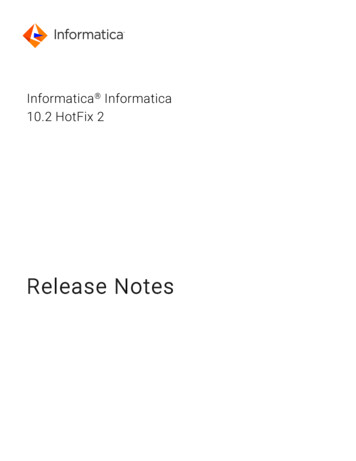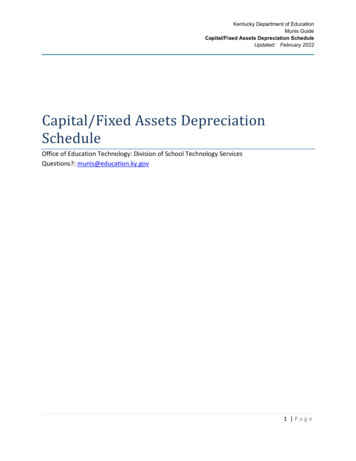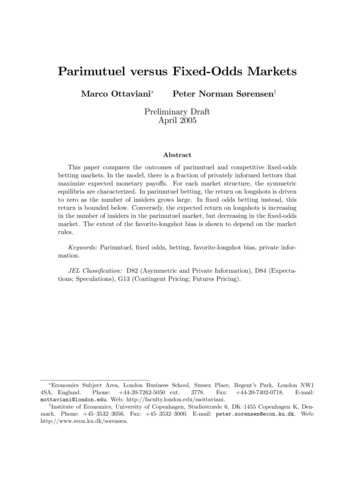
Transcription
Parimutuel versus Fixed-Odds MarketsMarco Ottaviani Peter Norman Sørensen†Preliminary DraftApril 2005AbstractThis paper compares the outcomes of parimutuel and competitive fixed-oddsbetting markets. In the model, there is a fraction of privately informed bettors thatmaximize expected monetary payoffs. For each market structure, the symmetricequilibria are characterized. In parimutuel betting, the return on longshots is drivento zero as the number of insiders grows large. In fixed odds betting instead, thisreturn is bounded below. Conversely, the expected return on longshots is increasingin the number of insiders in the parimutuel market, but decreasing in the fixed-oddsmarket. The extent of the favorite-longshot bias is shown to depend on the marketrules.Keywords: Parimutuel, fixed odds, betting, favorite-longshot bias, private information.JEL Classification: D82 (Asymmetric and Private Information), D84 (Expectations; Speculations), G13 (Contingent Pricing; Futures Pricing). Economics Subject Area, London Business School, Sussex Place, Regent’s Park, London NW14SA, England.Phone: 44-20-7262-5050 ext.3778.Fax: 44-20-7402-0718.E-mail:mottaviani@london.edu. Web: http://faculty.london.edu/mottaviani.†Institute of Economics, University of Copenhagen, Studiestræde 6, DK—1455 Copenhagen K, Denmark. Phone: 45—3532—3056. Fax: 45—3532—3000. E-mail: peter.sorensen@econ.ku.dk. Web:http://www.econ.ku.dk/sorensen.
1. IntroductionThis paper compares the performance of parimutuel with fixed-odds markets, the two mostcommon market structures used for betting. In parimutuel markets, a winning bet paysoff a proportional share of the total money bet on all outcomes, so that the odds offeredto a bet are determined only after all the bets are placed. In fixed-odds markets instead,bookmakers compete to set odds at which they accept bets from the public.Differently from regular financial markets, in betting markets the uncertainty is resolvedunambiguously and the fundamental values are publicly observed. In addition, these valuesare exogenous with respect to the market prices. Because of these features, betting marketsprovide an ideal testbed for evaluating theories of price formation (see Thaler and Ziemba1988, Hausch and Ziemba 1995, Sauer 1998, and Jullien and Salanié 2002 for surveys).A commonly observed empirical pattern is the favorite-longshot bias, according towhich horses with short market odds (favorites) offer higher average payoff than horseswith long market odds (longshots). In this paper, we show that this bias can result fromthe presence of privately informed bettors in both the parimutuel and fixed-odds marketstructures. We further argue that these two structures induce different systematic relationsbetween empirical and market odds, depending on the amount of information present inthe market.In the model, there are two classes of bettors, outsiders and insiders. While outsiderare uniformed and place an exogenous amount of bets, insiders are privately informed andmaximize their expected monetary payoff. We characterize how the symmetric equilibriumdepends on the market structure.First, consider the outcome of a competitive fixed-odds market. Relative to favorites,longshots attract a relatively higher proportion of insiders and pay out more conditionalon winning. To counteract this more severe adverse selection problem, competitive bookmarkers quote relatively shorter odds on longshots. This is the equivalent of a largerbid-ask spread in the presence of more insider trading in a standard financial market making mechanism (Glosten and Milgrom 1985). Since the adverse selection problem is greateron the longshot than on the favorite, a favorite-longshot bias arises.Consider next the case of parimutuel markets. The insiders simultaneously use theirprivate information to decide where to place their bets. As a result of insider cash con-1
straints, the market odds do not move sufficiently far to exhaust the gains revealed by theinformed bettors, and the favorite-longshot bias arises. Many (few) informed bets on ahorse indicates that this favorite (longshot) is less (more) likely to win than indicated bythe realized bet distribution.Our analysis of fixed-odds markets is closely related to Shin (1991 and 1992). Shinargues that a monopolistic bookmaker sets odds with a favorite-longshot bias in order tolimit the subsequent losses to the better informed insiders. We derive a similar bias ina competitive bookmaking market. Our informational assumptions are similar to thosemade by Shin, but we consider the case of ex-post rather than ex-ante competition amongbookmakers. Our results on the favorite-longshot bias in fixed-odds betting are thereforenew. Our analysis of parimutuel markets builds extensively on the results obtained byOttaviani and Sørensen (2004).To the best of our knowledge, this is the first paper that compares the performanceof trading structures used in betting markets. We study these two structures in isolation.When both markets coexist, bettors have the additional choice of participating in eithermarket, possibly depending on their information. The investigation of this selection issueis left to future research.1A number of alternative theories have been formulated to explain the favorite-longshotbias. First, Griffith (1949) suggested that the bias might be due to the tendency ofindividual decision makers to overestimate small probabilities events. Second, Weitzman(1965) and Ali (1977) hypothesized that individual bettors are risk loving, and so arewilling to accept a lower expected payoff when betting on the riskier longshots. Third,Isaacs (1953) noted that an informed monopolist bettor would not bet until the marginalbet has zero value, if the marginal bet reduces the return to the inframarginal bets. Fourth,Hurley and McDonough (1995) noted that the presence of the track take limits the amountof arbitrage by the informed bettors, who are prevented from placing negative bets and socannot take advantage of negative returns on longshots.While Isaacs’ (1953) market power explanation and Hurley and McDonough’s (1995)limited arbitrage explanation are specific to parimutuel markets, the informational explanation of the favorite-longshot bias proposed here applies both to parimutuel and fixed1For example, parimutuel and fixed odds markets coexist in the UK. See Gabriel and Marsden (1990)for an empirical investigation of the interaction effects resulting from the bettors’ option to select in whichsystem to participate.2
odds markets. The behavioral and risk loving explanations instead predict the presence ofthe bias regardless of the market structure, but do not account for the varying extent ofthe bias under different market institutions.The paper proceeds as follows. In Section 2 we formulate the information structure ofthe model. In Section 3 we analyze the equilibrium with fixed odds. In Section 4 we turnto parimutuel betting. Section 5 compares the outcomes of the two market structures.2. ModelWe consider a race between two horses. The outcome that horse x wins the race is identifiedwith the state, x { 1, 1}.Unmodelled outsiders place bets on the two horses without responding to the marketconditions. For simplicity, we assume that the same amount a 0 is bet on either horse.There is a continuum [0, N] of privately informed bettors (or insiders). Insiders (aswell as the bookmakers in the specification of Section 3) have a common prior beliefq Pr (x 1), possibly formed after the observation of a common signal. In addition,each insider i privately observed signal si .2 The signals are assumed to be identically andindependently distributed across insiders, conditional on state x. Since there are only twostates, the likelihood ratio f (s x 1) /f (s x 1) is monotone without further loss ofgenerality. For simplicity, we further assume that the likelihood ratio is strictly increasingin s.Upon observation of signal s, the prior belief q is updated according to Bayes’ ruleinto the posterior belief, p Pr (x 1 s). The posterior belief p is distributed accordingto the continuous distribution function G with density g on [0, 1]. By the law of iteratedR1expectations, the prior must satisfy q E[p] 0 pg (p) dp. Bayes’ rule yields p qg (p x 1) /g (p) and 1 p (1 q) g (p x 1) /g (p), so that the conditional densitiesof the posterior are g (p x 1) pg (p) /q and g (p x 1) (1 p) g (p) / (1 q). Notethat g (p x 1) /g (p x 1) (p/ (1 p)) ((1 q) /q), reflecting the property that highbeliefs in outcome 1 are more frequent when outcome 1 is true. Strict monotonicityof the likelihood ratio in p implies that G (p x 1) first-order stochastically dominatesG (p x 1) on the support, i.e., G (p x 1) G (p x 1) 0 for all p such that0 G (p) 1.2Private (or inside) information is believed to be pervasive in horse betting. See e.g., Crafts (1985).3
It is convenient to state assumptions on the signal structure in terms of their implications for the conditional distributions of the posterior belief. The signal distribution is saidto be symmetric if the chance of posterior p conditional on state x 1 is equal to the chanceof posterior 1 p conditional on state x 1, i.e., G (p x 1) 1 G (1 p x 1)for all p [0, 1]. The signal distribution is said to be unbounded if 0 G (p) 1 for allp (0, 1).Example. To illustrate our results we use the linear signal example, which can be derived from a binary signal with precision distributed uniformly. In this example, theconditional densities are f (s x 1) 2s and f (s x 1) 2 (1 s) for s [0, 1], withcorresponding distribution functions F (s x 1) s2 and F (s x 1) 1 (1 s)2 .The posterior odds ratio ispsq f (s x 1)q .1 p1 q f (s x 1)1 q1 s(2.1)Inverting p/ (1 p) qs/ (1 q) (1 s), we obtain s p (1 q) / (p (1 q) (1 p) q).The conditional distribution functions for p areµ¶2p (1 q)G (p 1) p (1 q) (1 p) qandG (p 1) 1 µ(1 p) qp (1 q) (1 p) q(2.2)¶2.(2.3)3. Fixed-Odds BettingWe begin by considering fixed-odds betting. After introducing the rules of the market(Section 4.1), we characterize the equilibrium (Section 4.2) and the resulting favoritelongshot bias (Section 4.3).3.1. Market RulesWe consider a market with competitive bookmakers operating as follows. First, the bookmakers simultaneously quote odds. We denote by 1 ρx 1/π x the return to every dollarbet on horse x offered by the bookmaker(s) making the most advantageous offer. Second,the bettors place their bets. The insiders are allowed to bet one dollar on either horse, orabstain from betting. In addition, there is a given amount of bets placed by unmodelled4
outsiders, and these outside bets are equal to a 0 on each of the two horses regardlessof the state. Third, the state x is realized, and bookmakers pay out the promised returnson the winning tickets.Note the difference of our model with Shin’s (1991 and 1992) model. Shin assumesthat the odds are set by a monopolist bookmaker, who is allowed to set odds on thedifferent horses at the same time and so cross-subsidize across the two markets. In hissetting, bookmarkers compete ex-ante for the monopoly position, and so make zero profitsin equilibrium of the full game, even if they do make non zero positive profits on themarket of each individual horse. We instead consider a separate competitive market foreach horse, as in Glosten and Milgrom’s (1985) market making model.3.2. Equilibrium CharacterizationWhen odds ρ1 are offered on horse 1, every insider with beliefs above the cutoff belief p1prefers to bet on horse 1 rather than to abstain, where p1 is defined by the indifferencep1 ρ1 1 p1 . Thus, the solution p1 1/ (1 ρ1 ) π 1 is precisely the implied marketprobability.By Bertrand competition, in equilibrium each bookmaker make zero expected profitsin the market corresponding to each horse. Taking into account the optimal response ofthe informed bettors, the bookmaker makes zero expected profits on horse 1 whenµµµ¶¶¶µµµ¶¶¶11q a N 1 G 1ρ1 (1 q) a N 1 G 1. (3.1)1 ρ11 ρ1To understand this, note that the bookmaker believes that horse 1 wins with probabilityq, in which case the bookmaker makes a net payment equal to ρ1 to a outsiders and tothe insiders with a belief above π 1 . If instead horse 1 wins, the informed place a loweramount of bets on the horse 1, since 1 G (π 1 1) 1 G (π 1 1) by the stochasticdominance property of beliefs.3An equilibrium on the market for horse 1 is defined by any ρ1 0 that solves equation (3.1). Observe that for ρ1 0, the left-hand side is strictly lower than the right handside, since 0 (1 q) a. As ρ1 , the left-hand side increases without bound and so3In Glosten and Milgrom’s model, the bookmakers earn zero expected profits conditional on the newsthat the next bettor wants to bet on horse 1. Indeed, (3.1) can be rewritten to confirm that π 1 is theposterior probability of state 1 given a bet on horse 1.5
exceeds the right-hand side, equal to the bounded (1 q) (a N). Thus there exists anequilibrium, that below is shown to be unique.Equation (3.1) may be rewritten as³³ 1a N1 G 11 ρ1 q1 q³³ 1 ρ1 qqa N 1 G 1 1(3.2)1 ρ1where the inequality is due to G (p 1) G (p 1). The left-hand side is the market odds,while the right-hand side gives the prior odds. Systematically, bookmakers quote marketodds shorter than the prior odds in order to protect their profits against the informationaladvantage of the insiders. This difference may be loosely interpreted as a bid-ask spread.It implies that a bet based on the prior belief q results in a negative expected return.3.3. Favorite-Longshot BiasNote that the implied market probability π 1 1/ (1 ρ1 ) that result in equilibrium departs systematically from the prior belief q that horse 1 wins. The corresponding empiricalaverage return to a bet on horse 1 is then q/π 1 1 0. In accordance with Shin’s (1991and 1992) definition, we say that the favorite-longshot bias arises if the ratio π1 /q is adecreasing function of q, in which case the empirical average return to a bet on horse 1 isincreasing in π 1 .We now establish that π1 is an increasing function of q and π1 /q is a decreasing functionof q:Proposition 1 There exists a unique constant factor µ 1, such that the market impliedprobability can be written as π 1 µq/ [µq (1 q)]. There is a favorite-longshot bias.Proof. Defining α a/N, and using the variable π 1 1/ (1 ρ1 ), the equilibriumcondition (3.1) is(1 q) π 1α 1 G (π 1 1) .q (1 π 1 )α 1 G (π1 1)(3.3)Here, the left hand side is continuous and strictly increasing in π 1 , being 0 at π 1 0 andtending to infinity as π 1 1. The right-hand side is continuous with value 1 at both endsπ 1 0, 1. Thus, for every given q (0, 1) there exists a solution π 1 to (3.3).6
This solution is unique, for whenever equation (3.3) holds, the right-hand side intersectsthe left hand side from above. This follows, since the slope of the right-hand side at anintersection is1g (π 1 1) g (π 1 1) (1 q)πg (π 1 1) (α 1 G (π 1 1)) g (π 1 1) (α 1 G (π 1 1))q(1 π 1 ) (α 1 G (π 1 1))(α 1 G (π 1 1))2where the equality followed from (3.3). By g (π1 1) /g (π 1 1) (π1 / (1 π 1 )) ((1 q) /q),we see that this slope is in fact zero. Since the left hand side is increasing, the intersectionis from above, as claimed.So far we have established that for every q there exists a unique solution π 1 to (3.3).We now describe how π 1 depends on q. Recall that the distribution G of the posteriorbelief depends on q, so we aim first to rewrite (3.3) in terms of the fixed signal distributionF . Bayesian updating gives π 1 (1 q) / [(1 π 1 ) q] f (s 1) /f (s 1), and since thelikelihood ratio f (s 1) /f (s 1) is strictly monotone, we can recover s as a function σof the variable µ π 1 (1 q) / [(1 π 1 ) q]. Using the relationship between s and π 1 , forgiven q we defined G (π 1 x) F (s x). Now (3.3) reduces toµ α 1 F (σ (µ) 1)α 1 F (σ (µ) 1)(3.4)The existence of the unique solution for π 1 given q to equation (3.3) implies that thereexists a likewise unique solution in µ to equation (3.4). Namely, consider q 1/2 andtake the π1 that solved (3.3), let µ π 1 / (1 π 1 ) and note that this is a solution to (3.4).On the other hand, if µ0 6 µ also solved (3.4), then π 01 µ0 / (1 µ0 ) 6 π 1 would alsosolve (3.3) for q 1/2, in contradiction to its uniqueness.As noted in (3.2), the market odds are shorter than the prior odds, so µ 1. Rewriting,we see that π 1 µq/ [µq (1 q)]. Thus π 1 is an increasing function of q, while π 1 /q µ/ [µq (1 q)] is a decreasing function of q since µ 1. Thus, there is a favorite-longshot bias.As the chance q that horse 1 wins is increased, the bookmaker naturally sets shorterodds for horse 1. This drives away some of the informed bettors, but we have assumedthat the outsiders keep betting the same amount. Thus, the bookmaker’s adverse selectionproblem is reduced, and in equilibrium the implied market probability π 1 is brought closerto the prior probability q. Yet, we showed that the ratio π 1 /q falls. The subtlety of the7
result is underlined by the fact that the ratio of market odds to prior odds is constant withrespect to q and equal to 1/µ.The factor µ is a decreasing function of the ratio a/N of outsider to insider populationsizes, since the bookmaker’s adverse selection problem is smaller when the outsiders placemore bets in comparison to the insiders. This implies that the favorite-longshot bias ismore pronounced when there are more insiders.Proposition 2 The factor µ, and thus the extent of the favorite-longshot bias, is a decreasing function of a/N.Proof. An increase in α a/N serves to decrease the right-hand side of (3.3) for everyπ 1 (0, 1). This follows from the first-order stochastic dominance property 1 G (π 1 1) 1 G (π 1 1). The strictly increasing left-hand side is not affected by the change in α,so the equilibrium value of π1 must be smaller than before for every q. This implies thatµ π 1 (1 q) / [(1 π 1 ) q] is smaller, and closer to one, than before. Example. In the special symmetric signal distribution example, G is defined by (2.2)and (2.3). Defining α a/N, and using the variable π 1 1/ (1 ρ1 ), the equilibriumcondition (3.1) is then 2³π 1 (1 q)α 1 π 1 (1 q) (1 π 1 )q(1 q) π 1 2 .³q (1 π 1 )(1 π 1 )qα π1 (1 q) (1 π1 )q(3.5)Using µ (1 q) π 1 / [q (1 π 1 )], this equation further reduces to the cubic αµ3 αµ2 (1 α) µ (1 α) 0. Eliminating the useless root µ 1, this reduces to the quadraticpαµ2 (1 α) 0 which is solved by µ (1 α) /α 1, decreasing in α. Figure 3.1displays the expected return q/π 1 1 against market odds (1 π 1 ) /π 1 , for five values ofα. Notice the similarity of this figure with Jullien and Salanié’s (2002) Figure 1, derivedfrom bookmakers’ odds data for horse races run in Britain between 1986 and 1995 (seealso Jullien and Salanié 2000).4. Parimutuel BettingThis section reviews how the favorite-longshot bias arises from simultaneous informed betting, as derived in Ottaviani and Sørensen (2004). We first introduce the rules of the mar8
Figure 3.1: The expected return to a bet on outcome 1 in the fixed-odds market is plottedagainst the market odds ratio in the linear signal example. The five curves show the casesa/N 2, 1, .4, .2, .1, in progressively thicker shade.ket (Section 4.1). We then characterize the equilibrium and derive the bias (Section 4.2).Finally, we illustrate how the bias varies with the number of insiders (Section 4.3).4.1. Market RulesWe assume that the informed bettors can bet only a limited amount 1, and bet in orderto maximize their expected return. The total amount bet by these insiders on outcome yin state x is denoted by by x . All bets on both outcomes are placed in one common pool,from which is subtracted the track take τ [0, 1). The remaining pool is returned to thewinning bets. Thus, if x is the winner, each unit bet on outcome x yieldsW (x x) (1 τ )2a bx x b x x.a bx x(4.1)Notice the important difference to the case of fixed-odds betting, that each horse cannotbe studied in isolation – the return on horse x is influenced by the amount bet also onhorse x. With a continuum of small informed bettors, we assume each of them takes thereturns W (x x) as given.44.2. Equilibrium CharacterizationWith several bettors possessing private information, we solve the model for a Bayes-Nashequilibrium. Each bettor takes the correct equilibrium numbers W (x x) as given, and4Ottaviani and Sørensen (2005) consider finitely many insiders.9
chooses a best reply. Naturally, the greater is the belief in an outcome, the more attractiveit is to bet on that outcome. This leads to the following result.Proposition 3 Assume that the private beliefs distribution is unbounded, and that 0 τ 1/2. There exists a unique equilibrium. An insider bets on 1 when p p̂ 1 , abstainswhen p̂ 1 p p̂1 , and bets on 1 when p p̂1 , where the thresholds 0 p̂ 1 p̂1 1constitute the unique solution to the two indifference conditionsp̂1 a N (1 G (p̂1 1))11 τ 2a N (1 G (p̂1 1)) NG (p̂ 1 1)(4.2)a NG (p̂ 1 1)1.1 τ 2a N (1 G (p̂1 1)) NG (p̂ 1 1)(4.3)and1 p̂ 1 Proof. See Proposition 1 of Ottaviani and Sørensen (2004). Once the bettors use threshold strategies, we obtain b1 x 1 G (p̂1 x) and b 1 x G (p̂ 1 x). The conditions (4.2) and (4.3) express that the threshold bettor is exactlyindifferent among betting and abstaining, i.e., p̂1 W (1 1) (1 p̂ 1 ) W ( 1 1) 1.4.3. Favorite-Longshot BiasIn the parimutuel market, by definition, the implied market probability for outcome xis (1 τ ) /W (x x), equal to the fraction of money placed on outcome x. The favorite-longshot bias claims that the greater is this implied market probability, the greater theexpected return to a dollar bet on x. Conditioning on the realization of this implied marketprobability, the empirical researcher can estimate the expected return to a bet on x. Inour model, with the continuum of privately informed bettors, strictly more bets are placedon outcome x when it is true than when it is false. Thus, the realized bets fully reveal thetrue outcome. We conclude that the equilibrium outcome exhibits the favorite-longshot¡ bias. The insiders’ bets b1 x , b 1 x reveal the true winner, and although horse x is moreof a favorite (bx x bx x ) when it wins, the market implied probability for the winner isless than one.5When the insiders place a greater share of all bets, they have a greater impact on themarket odds. Likewise, when τ decreases, the rational insiders are keener on betting, and5Ottaviani and Sørensen (2005) investigate more generally the conditions for the occurrence of thefavorite-longshot bias with a finite number of players. The sign and extent of the bias depends on theinteraction of noise and information.10
therefore have greater impact on the market odds. Either change has the effect of reducingthe favorite-longshot bias.Proposition 4 Assume that the distribution of private posterior beliefs is symmetricand unbounded, and that 0 τ 1/2. The unique equilibrium of Proposition 3 satisfiesp̂1 1 p̂ 1 (1/2, 1). The threshold p̂1 is increasing in τ and N/a. The favorite-longshotbias is reduced when either a/N or τ is decreased.Proof. See Proposition 4 of Ottaviani and Sørensen (2004). Example. In the linear signal example with fair prior (q 1/2) and track take τ 1/2,the unique symmetric-policy Nash equilibrium has an explicit expression, with cutoff beliefq¡ (1 τ ) (1 a/n) (1 a/N) τ 2 (1 τ )2 a/Np̂1 [1/2, 1) .(1 2τ )5. Comparison of Market StructuresWe have established that the favorite-longshot bias can arise as the result of informedbetting in both parimutuel and fixed-odds markets. Figure 3.1 illustrates the extent ofthe favorite-longshot bias under fixed-odds betting. This plot can be easily comparedwith a plot generated with data obtained from fixed-odds betting. However, we have notproduced any directly comparable plot for parimutuel betting, since the market odds havedifferent meanings in the two market structures. In this section, we propose a method forcomparing the extent of the favorite-longshot bias in these two market structures.To verify the presence of the favorite-longshot bias in the two settings, we have studiedthe relation between the empirical odds and the market odds. But the market oddsare different in the two settings. In fixed-odds betting, the bookmaker uses the priorprobability q as a basis for quoting the market implied probability π1 , which is thenassociated with the empirical chance q. In parimutuel betting, however, the market impliedprobability π k/N results from the volume of bets placed on the two horses. Sincethis random volume reveals information, it is associated with the empirical (Bayesian)probability 1/ (1 β).In order to compare the extent of the favorite longshot bias in the two models, weperform the following transformation of the odds generated in the parimutuel market. For11
return0.2501.252.53.75odds50-0.25-0.5-0.75-1Figure 5.1: The average return to a parimutuel bet on horse 1 is plotted against the averagemarket odds ratio in the linear signal example. All plots have τ .15, and show the resultsas q varies in the interval (.1, .9). The five curves show the cases a/N 2, 1, .4, .2, .1, inprogressively thicker shade.any value of the prior probability q, in the parimutuel market we determine the averagemarket implied probability for horse 1 and the average return to an extra bet on horse 1.Varying q (0, 1) parametrically, we then obtain a plot of returns against market impliedprobabilities, directly comparable to Figure 3.1 obtained for the fixed-odds market.The amount of bets on horse 1 is a N (1 G (p̂1 x)) when x is the winner. Theaverage market implied probability for horse 1 is thenqa N (1 G (p̂1 1))a N (1 G (p̂1 1)) (1 q).2a N (1 G (p̂1 1)) NG (p̂ 1 1)2a N (1 G (p̂1 1)) NG (p̂ 1 1)Ex ante, the expected payoff of a marginal extra bet on horse 1 isqW (1 1) 1 q2a N (1 G (p̂1 1)) NG (p̂ 1 1) 1.a N (1 G (p̂1 1))Using the equilibrium conditions (4.2) and (4.3), we can solve for (p̂1 , p̂ 1 ) as a function ofq and compute these quantities. Figure 5.1 shows the resulting plot in our linear example,when the track take is τ .15. We have solved the system numerically, using Maple.6In the parimutuel system, the amount bet on the longshot is almost completely lost.This is because the limited interest obtained by longshots is bad news about their chanceof winning. In comparison, Figure 3.1 reveals that the loss to a bet on a longshot isbounded below. In fixed-odds betting, an ex-ante longshot is unlikely to attract insiders,so competition among bookmakers leads them to set more attractive odds on longshots.6Our Maple worksheet is available upon request.12
A related striking feature of Figure 5.1 is that favorites present a strictly positive return,when the number of insiders is small. This arbitrage opportunity arises since the cashconstrained insider population cannot correct the mis-pricing inherent in the fair noisebets.Finally, we observe in Figure 5.1 that in parimutuel betting the expected loss to a givenlong market odds ratio is decreasing in the population share of insiders. To intuitivelyunderstand this, notice that a long odds ratio (a b 1 ) / (a b1 ) 1 arises for a smallerinformation ratio b 1 /b1 when the total amount of insiders bets (both b 1 and b1 ) arelarger. Thus, the same ratio is actually less informative news against the longshot, whenthe insider population is larger. So, for relative longshots, more insider betting serves tolimit the losses to uninformed bettors (who bet on the longshot). In contrast, in fixed-oddsmarkets the bookmaker always increases the spread in the presence of more insiders.The comparative statics of the favorite-longshot bias with respect to the prevalenceof insider betting works differently depending on the market structure. In parimutuelmarkets an increase in the number of uninformed bettors results in more of a bias for anygiven market odds realization, but at the same time drives market odds towards greaterextremes where the bias is smaller. In fixed-odds markets instead, an increase in thefraction of uninformed bettor results in a reduction of the markup and so in less favoritelongshot, due to the fact that the adverse selection is reduced if there are more uninformedbettors.13
ReferencesAli, Mukhtar M., “Probability and Utility Estimates for Racetrack Bettors,” Journal ofPolitical Economy, 1977, 85(4), 803—815.Crafts, Nicholas, “Some Evidence of Insider Knowledge in Horse Race Betting in Britain,”Economica, 1985, 52(207), 295—304.Gabriel, Paul E. and James R. Marsden “An Examination of Market Efficiency in a BettingMarket,” Journal of Political Economy, 1990, 98(4), 874—885.Glosten, Lawrence and Paul Milgrom, “Bid, Ask and Transaction Prices in a SpecialistMarket with Heterogeneously Informed Traders,” Journal of Financial Economics, 1985,14(1), 71—100.Griffith, R. M., “Odds Adjustment by American Horse-Race Bettors,” American Journalof Psychology, 1949, 62(2), 290—294.Hausch, Donald B. and William T. Ziemba, “Efficiency of Sports and Lottery BettingMarkets,” in the Handbook of Finance, edited by R. A. Jarrow, V. Maksimovic, and W.T. Ziemba (North Holland Press), 1995.Hurley, William and Lawrence McDonough, “Note on the Hayek Hypothesis and theFavorite-Longshot Bias in Parimutuel Betting,” American Economic Review, 1995, 85(4),949—955.
bookmakers. Our results on the favorite-longshot bias in fixed-odds betting are therefore new. Our analysis of parimutuel markets builds extensively on the results obtained by Ottaviani and Sørensen (2004). To the best of our knowledge, this is the first paper that compares the performance of trading structures used in betting markets.
